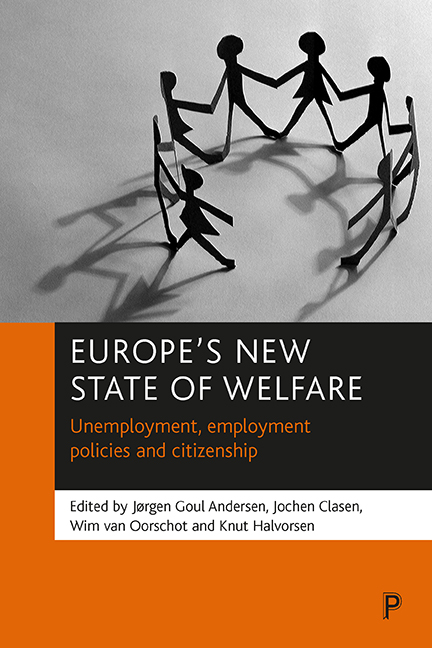Book contents
- Frontmatter
- Contents
- Notes on contributors
- Glossary
- Preface
- one Changing labour markets, unemployment and unemployment policies in a citizenship perspective
- two Employment and unemployment in Europe: overview and new trends
- three Unemployment and unemployment policy in the UK: increasing employability and redefining citizenship
- four To be or not to be employed? Unemployment in a ‘work society’
- five France: the impossible new social compromise?
- six Labour market participation in the Netherlands: trends, policies and outcomes
- seven Is high unemployment due to welfare state protection? Lessons from the Swedish experience
- eight Denmark: from the edge of the abyss to a sustainable welfare state
- nine Unemployment and (un)employment policies in Norway: the case of an affluent but oil-dependent economy: the paradox of plenty?
- ten Unemployment and unemployment policy in Finland
- eleven Slovenia’s navigation through a turbulent transition
- twelve Unemployment and unemployment policy in Switzerland
- thirteen Work, welfare and citizenship: diversity and variation within European (un)employment policy
- References
- Index
- Also available from The Policy Press
twelve - Unemployment and unemployment policy in Switzerland
Published online by Cambridge University Press: 20 January 2022
- Frontmatter
- Contents
- Notes on contributors
- Glossary
- Preface
- one Changing labour markets, unemployment and unemployment policies in a citizenship perspective
- two Employment and unemployment in Europe: overview and new trends
- three Unemployment and unemployment policy in the UK: increasing employability and redefining citizenship
- four To be or not to be employed? Unemployment in a ‘work society’
- five France: the impossible new social compromise?
- six Labour market participation in the Netherlands: trends, policies and outcomes
- seven Is high unemployment due to welfare state protection? Lessons from the Swedish experience
- eight Denmark: from the edge of the abyss to a sustainable welfare state
- nine Unemployment and (un)employment policies in Norway: the case of an affluent but oil-dependent economy: the paradox of plenty?
- ten Unemployment and unemployment policy in Finland
- eleven Slovenia’s navigation through a turbulent transition
- twelve Unemployment and unemployment policy in Switzerland
- thirteen Work, welfare and citizenship: diversity and variation within European (un)employment policy
- References
- Index
- Also available from The Policy Press
Summary
Introduction
Unemployment in Switzerland is low, by international standards. In 2001, unemployment averaged a mere 1.9%, compared to 7.8% in the EU and 4.8% in the US. Swiss unemployment, however, has not always been this low. In fact, starting from 0.5% in 1990, the unemployment rate rose to 5.2% in just four years and topped off at an unprecedented 5.7% in the winter of 1997, before decreasing to its present level. Not even during the Great Depression in the 1930s did unemployment rise that high in Switzerland.
While the recent rapid decline in Swiss unemployment was remarkable by international standards, the unemployment rate nevertheless failed to fall back to its pre-recession level of 0.5%. In this respect, the time path of baseline unemployment in Switzerland has risen in a step-like fashion from one business cycle to the next, a pattern repeated in other European countries. By contrast, the unemployment rate in the US tends to fluctuate around a stationary baseline level of about 6%, rising above this mark in a cyclical downturn and falling below it in an upswing.
A high level of baseline unemployment is costly both to the unemployed as well as to society as a whole. Depending on the amount of turnover in unemployment and on the generosity of unemployment insurance (UI) benefits, a high baseline level of unemployment subjects the unemployed to significant financial and emotional stress. Moreover, it leads to a loss of output, lowering the standard of living available to all. Furthermore, it strains the government budget by raising spending (on income support schemes, for example) while at the same time lowering tax revenues.
The following contribution examines the causes and consequences of the increase in baseline unemployment in Switzerland. Section two of this chapter documents the rise in baseline unemployment, while section three discusses the causes of this increase. Section four then assesses the policy response to the unemployment increase. Conclusions are drawn in section five.
Rise in baseline unemployment
A number of signs exist which point to an increase in baseline unemployment in Switzerland. One such piece of evidence is the unemployment rate itself.
- Type
- Chapter
- Information
- Europe's New State of WelfareUnemployment, Employment Policies and Citizenship, pp. 217 - 232Publisher: Bristol University PressPrint publication year: 2002

